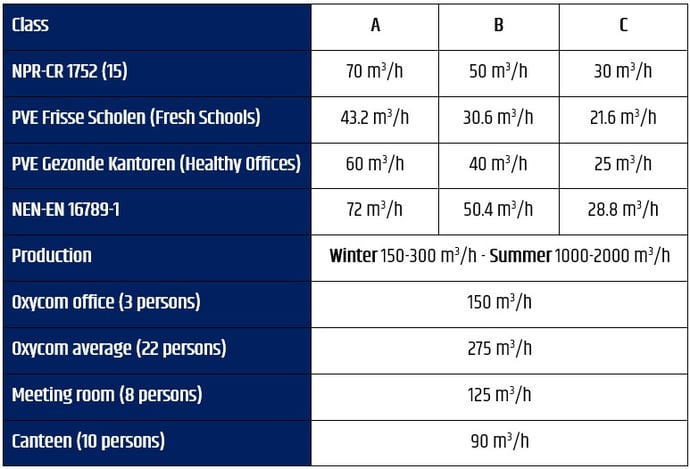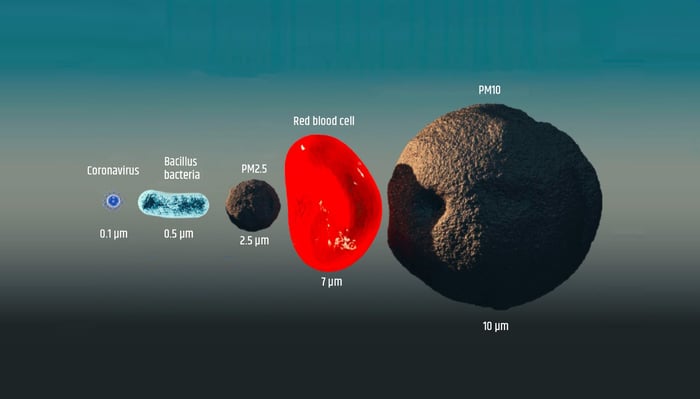The coronavirus crisis has held the world on tenterhooks for almost a year now. Over the course of this year, researchers have published numerous studies on the relationship between aerosols and the spread of viruses, including the COVID-19 virus. Aerosols are tiny droplets, released during exhalation. These small droplets are incredibly lightweight and do not immediately sink to the bottom. When there is little or no ventilation, aerosols can remain floating in the air for a long time. In an enclosed, poorly ventilated room, keeping 1,5 meters distance from one another has little to no effect as a measure against contamination when an infected person is or has been recently present. But how do you measure that an enclosed space is safe from contamination via aerosols? And what can you do to ensure a room is as safe as possible?
The relationship between the CO2 content and the presence of aerosols
The amount of aerosols in the air is not directly measurable, but research shows a clear correlation between the concentration of CO2 emitted via breathing and that of aerosols. The higher the concentration of CO2 in a room, the higher the concentration of aerosols. Consequently, by reducing the CO2 content in a room, the risk of contamination via aerosols is also reduced.Oxycom’s PreCooll system can be used to retrofit condensers installations.
Ventilation is key
Optimal ventilation of rooms plays a significant role in reducing the risk of infection. By continually refreshing the air, the CO2 content decreases considerably, and so does the concentration of aerosols.
The Wells-Riley model, an infection risk model from the health care sector, indicates the required amount of air renewal to keep the chance of infection via aerosols below 5%, if an infected person is, or has been present in a room.
Below are the summarized guidelines for offices, meeting rooms, and canteens (Corona en de toekomst van ventilatie-eisen in Nederland, TVVL magazine / onderzoek & cases 05 / October / 2020)
- Offices (exposure: 6 hours): 150 m³/h/person
- Meeting room (exposure: 4 hours): 125 m³/h/person
- Canteen (exposure: 2 hours): 65m³/h/person
In addition to the fact that sufficient ventilation with fresh air reduces the risk of contamination via aerosols, regularly ventilating rooms and spaces has many more benefits. Optimal ventilation increases concentration levels, productivity, and general well-being in the workplace, school, and home.
The simplest way to ventilate a room is to open a window. However, this is not always possible (absence of windows, noise pollution, etc.), and often provides insufficient ventilation for the entire room. An adequate ventilation system is, therefore, necessary. Oxycom's IntrCooll system ventilates with 100% fresh outside air, refreshing the air content of a room several times an hour. When necessary, the IntrCooll can also cool the air down to create a pleasant indoor climate, using only a small amount of electricity.
Upgrade your existing ventilation system with the IntrCooll now. For more information, please read this blog or contact us directly.
Take a peek inside Oxycom
Practice what you preach' they say, provided you want to remain credible. At Oxycom, we use the FreshCooll installations to ventilate our building optimally. This new product, which is still in the test phase, can be used during all four seasons to provide rooms with 100% fresh air. This year, Oxycom installed 3 FreshCooll units in our offices. Our production area was already cooled and ventilated properly by our IntrCooll units. Measurements in these rooms show that the air quality is far above the applicable guidelines, and the chance of contamination via aerosols is below 5%. Table 1.: Recommended ventilation according to guidelines based on NPR-CR 1752 (15), PVE Fresh Schools, PVE Healthy Offices and NEN-EN 16789-1. Where A is very good, B is good, and C is sufficient according to these standards.
Table 1.: Recommended ventilation according to guidelines based on NPR-CR 1752 (15), PVE Fresh Schools, PVE Healthy Offices and NEN-EN 16789-1. Where A is very good, B is good, and C is sufficient according to these standards.
Oxycom figures versus the Wells-Riley model:
- Office Oxycom: 150 m³/h/person - Wells-Riley: 150 m³/h/person
- Meeting room Oxycom: 150 m³/h/person - Wells-Riley: 125 m³/h/person
- Canteen Oxycom: 90 m³/h/person - Wells-Riley: 65m³/h/person
 Download our whitepaper “Challenges and Opportunities for Energy-Efficient Climate Control”, and discover how you can create a healthy and sustainable indoor climate within your production facility.
Download our whitepaper “Challenges and Opportunities for Energy-Efficient Climate Control”, and discover how you can create a healthy and sustainable indoor climate within your production facility.
Protect yourself and start ventilating your workspace as optimally as possible. Contact us and let us advise you, free of charge, on the best solution for you.





